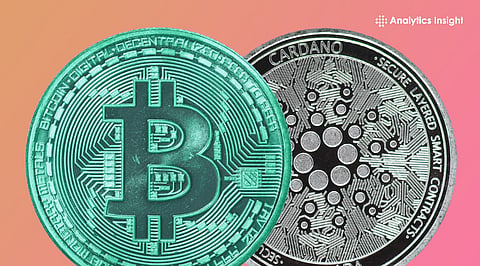

Bitcoin’s fixed supply and heavy institutional inflows support long-term value growth without requiring new upgrades or applications.
Cardano’s tech is strong, but adoption remains weak with low TVL, fewer active wallets, and stiff competition from dominant chains.
For a $1,000 investment in 2025, Bitcoin offers a clearer risk-reward profile, while Cardano requires multiple ecosystem breakthroughs to compete.
Crypto investors face a familiar situation: invest in a proven leader like Bitcoin or a technologically ambitious blockchain like Cardano. They are at different ends of the spectrum, so if you plan on investing $1,000 in the cryptocurrency market, it is important to understand why they are in separate camps.
Bitcoin is not like other blockchain projects that need to redevelop themselves to remain relevant. Its investment case is supported by scarcity, predictable issuance, and well-established function as digital money.
Bitcoin's monetary policy is hard-coded: there will always only be 21 million coins in existence, with more than 19.9 million coins already mined. Every four years, there is a halving, which cuts the flow of new Bitcoin by 50% reinforcing the supply squeeze.
This scarcity remains Bitcoin's greatest asset, particularly with increasing institutional participation. The emergence of spot Bitcoin ETFs and digital asset treasury (DAT) firms has brought long-term buyers who are now accumulating BTC and rarely selling.
In 2024 and 2025, ETF inflows amounted to billions of dollars, setting weekly records and restricting available supply.
You don’t need “what’s next” to justify the value of Bitcoin. It doesn’t need faster transaction speeds, new sophisticated layers for smart contracts, or more disruptive new applications.
As long as Bitcoin is scarce, censorship-resistant, globally liquid, and easy to own via regulated investment products, the long-lasting value proposition holds.
Put simply, Bitcoin can continue appreciating even if the protocol never changes again because demand grows while supply shrinks.
Also Read: Bitcoin Price Falls to $85,350 as Market Hits Seven-Month Low
Cardano represents the opposite end of the spectrum. It depends on continuous development, feature rollouts, and ecosystem expansion. Conceptually, it is impressive with a peer-reviewed architecture, energy-efficient design, and a roadmap built around careful, staged upgrades.
Cardano offers smart contracts, decentralized applications, stablecoins, and a capped maximum supply of 45 billion tokens. On paper, it has the components needed to support a thriving economy.
But the issue is not capability; it is adoption.
Cardano struggles to compete with larger smart-contract platforms like Ethereum, Solana, BNB Chain, and even emerging chains focusing on real-world assets (RWAs) or AI-driven workflows.
By key metrics, total value locked (TVL), developer activity, transaction volume, dApp traction, and institutional usage, Cardano consistently lags behind its rivals.
As of mid-November 2025:
Its TVL is approximately $257-$271 million, tiny compared to chains with tens of billions.
Daily active wallets hover around 25,000, a fraction of competitor ecosystems.
No breakout dApp or category-defining stablecoin has emerged.
Liquidity, integrations, and capital inflows remain limited.
Cardano’s challenge is not a lack of innovation; it is overcoming established network effects. Smart-contract platforms are winner-take-most markets, and Cardano is still fighting for relevance in nearly every category that matters.
Could Cardano eventually catch up? It is possible, but the path requires multiple things to go right at the same time: deeper liquidity, institutional comfort, stronger stablecoin presence, and major developer migration. Meanwhile, competitors continue to accelerate.
Also Read: Cardano Founder Hoskinson Renews Proposal to Help Musk Evolve Dogecoin
When comparing the investment cases, the contrast is clear.
Bitcoin has a single, powerful edge: engineered scarcity amplified by institutional adoption. Its monetary policy is fixed, its supply is limited, and demand is increasingly driven by large, long-term holders.
Its value does not depend on innovation cycles or competitive battles.
Cardano, in contrast, requires multiple catalysts to align before its price can grow. It must gain market share, attract developers, deepen liquidity, and compete with chains that already dominate the sectors.
One asset requires nothing new to go right. The other requires almost everything to go right.
If you’re looking to invest $1,000, Bitcoin is a fundamentally strong choice. Its scarcity, institutional legitimacy, and increased macro-driven demand makes it one of the strongest hedge dynamic assets for the long term.
Cardano's technology is promising, but the gap to adoption and competition around it makes it a riskier bet.
Bitcoin remains the asset that is most likely to hold and appreciate over the coming years. Cardano may also have upside. Although the future remains uncertain and the path is filled with obstacles.
1. Is Bitcoin or Cardano better for $1,000?
Bitcoin because its scarcity and adoption make it a more reliable long-term asset.
2. Why is Cardano riskier?
Its ecosystem lacks liquidity, developer traction, and a dominant market share.
3. Can Cardano beat Bitcoin?
Only if it gains major adoption, deeper liquidity, and breakout apps, which is uncertain.
4. Why is Bitcoin’s thesis stronger?
It doesn’t need new features; predictable scarcity and demand drive price growth.
5. Should beginners choose Bitcoin?
Yes, its stability, liquidity, and lower risk make it ideal for first-time crypto investors.
Join our WhatsApp Channel to get the latest news, exclusives and videos on WhatsApp
_____________
Disclaimer: Analytics Insight does not provide financial advice or guidance on cryptocurrencies and stocks. Also note that the cryptocurrencies mentioned/listed on the website could potentially be scams, i.e. designed to induce you to invest financial resources that may be lost forever and not be recoverable once investments are made. This article is provided for informational purposes and does not constitute investment advice. You are responsible for conducting your own research (DYOR) before making any investments. Read more about the financial risks involved here.
